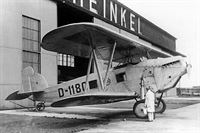Фотографии
-
Заправка приборов ВАП-4 на штурмовиках Р-5Ш во время учений, Аэродром 15-го ШАП под Читой, 1938 г.
A flight of R-5s is refuelled for another mission. An air brigade of 100 R-5s, each fitted with four VAP-4m containers, flying at an altitude of 50m (160ft) could discharge a cumulative total of some 4,500kg (9,900lb) of mustard gas in a single mission - at least in theory.Самолёты на фотографии: Поликарпов Р-5 - Россия - 1928
-
Регистрационный номер: D-251 Один из ранних "Юнкерс" F13 выпуска 1920г., но с доработанным трапециевидным килем, установленным в 1926г.
Junkers-F 13 D-251 (minus hyphen in this photograph) was used by the Germans for poison-gas tests in the Soviet Union from 1926. Like many aircraft secretly owned by the German military, D-251 was registered to the Deutsche Versuchsanstalt fyr Luftfahrt (DVL - German Aviation Research Institute).Самолёты на фотографии: Junkers F 13 - Германия - 1919
-
Регистрационный номер: D-507 Although of poor quality, this rare photograph shows Junkers-F 13 D-507 undergoing secret airborne chemical warfare tests at Rossitten in German East Prussia in 1925.
Самолёты на фотографии: Junkers F 13 - Германия - 1919
-
Регистрационный номер: D-831 After its withdrawal from airborne poison-gas testing with D-251 at Podosinki during 1926-27, Junkers-F 13 D-831 was used by the DVL for trials with experimental tail surfaces, as seen here, to explore methods of reducing control forces. It was later registered to the Reichsverband der Deutschen Luftfahrtindustrie (RDL - National Association of the German Aviation Industry).
Самолёты на фотографии: Junkers F 13 - Германия - 1919
-
Регистрационный номер: D-719 Another extremely rare photograph, this time showing Junkers-A 35 D-719 (right), with all markings removed, and an F13 at Podosinki circa 1926-27.
Самолёты на фотографии: Junkers A 20 / A 35 / K 53 - Германия - 1923Junkers F 13 - Германия - 1919
-
In 1936 a Tupolev TB-3 M-34RN was equipped as a flying laboratory (TB-3LL) for Soviet chemical warfare research, and cleared the use of the VAP-500, as seen here fitted to the belly of a TB-3. Perhaps surprisingly, battlefield chemical warfare was never used by the Soviets (or Germans), even at the brutal height of the Second World War.
Самолёты на фотографии: Туполев ТБ-3РН - Россия - 1934
-
Регистрационный номер: D-1180 The third Heinkel HD 40 single-engined transport/light bomber, HD 40 II D-1180, was acquired in 1927 specifically for poison-gas and chemical warfare trials. Registered to the DVL, it was ordered through the offices of Firma Schulz & Co of Berlin, one of the various cover organisations created for chemical warfare experiments.
Самолёты на фотографии: Heinkel HD.27/39/40/44 - Германия - 1926
Статьи
- -
- A.Tincopa - Wings over Peru
- B.Turpin - Brief encounter
- F.Villeneuve - Hawk One (1)
- J.-C.Carbonel - France's Air Pioneers: Louis Damblanc
- K.Hayward - AFVG "A political problem for both sides..."
- L.Andersson - Dirty secrets
- M.Wickstead - Italy's forgotten airlines (1)
- P.Davidson - Off the Beaten Track...
- P.Jarrett - Lost & Found
- P.Lewis - Switzerland's Tiger Force
- P.Vabre - From Flying to Spying (2)
- T.Culbert - The Hump pioneers
- U.Vicenzi - "The most important Bristol engine of all time"






